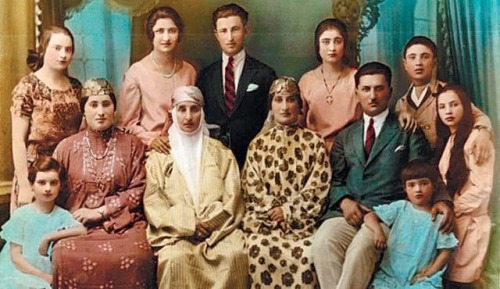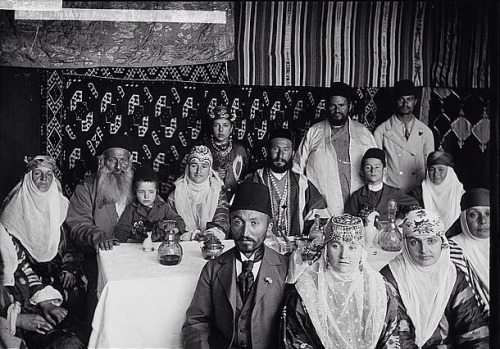everythingcentralasia:Bukharian Jews (also Bukharan Jews) stem from Central Asia and speak Bukhori
everythingcentralasia: Bukharian Jews (also Bukharan Jews) stem from Central Asia and speak Bukhori, a northern dialect of Tajiki language. The origin of Bukharian Jews can be traced back to the destruction of the Northern Israelite and Judean kingdoms. Exiled Jews left in droves, mostly northern and western, but a smaller number settled in the east, in what was then the Persian Empire. Many of them made the city of Bukhara their home, hence the name “Bukharian” Jews. In the 600s, the Arab conquest of Central Asia began and Islam became the dominant religion of the region. It was already evident here that the Bukharian Jews were taking steps to protect themselves from assimilation. They strove to live together in Jewish neighborhoods, and lived under their own rule with a community chief, called a kalontar. Despite varying levels of self-imposed segregation, cultural exchange did take place, and one can see many similarities in music, dance, food, and dress between Bukharian Jews and other Central Asian populations. During the spread of Islam in the 7th and 8th centuries, control of Bukhara was transferred between many different Islamic administrations. In 1219, the Mongols, led by Genghis Khan, conquered Bukhara, pillaging and burning the city to the ground, destroying the Bukhara Jewish community. In the beginning of the 16th century, Central Asia was invaded and conquered by nomadic Uzbek tribes who established strict observance of Islam and religious fundamentalism. During this period many Jews were forced to convert to Islam. The town of Bukhara eventually became a center of Jewish life in Central Asia, absorbing Jews fleeing cities located in the midst of battles between warring Islamic parties. More Jews relocated to Bukhara when the city of Samarkand was destroyed by an earthquake in the 16th century. Because of their ability to speak numerous languages, Bukharian Jews often acted as liaisons between various groups of foreign traders. Some Jews were financiers, others were known for their crafts, especially the dyeing of cloth, and silk weaving. Wealthier Jews invested in caravans which traveled the Great Silk Road. In the middle of the 19th century, many Bukharian Jews began to move to Palestine, and there they established the well known Bukharian Quarter (Sh’hunat Buhori), that still exists today in Jerusalem. They had arrived by railroad and on animals, many bought land in Jerusalem either to live in, or to visit; some desired to hold onto the land in the event of a pogrom or persecution from which they would have to flee from their native land. At this time, many Jews began to support many of the Russian influences on Central Asia as a way to escape the persecution they had faced under the Muslim governments. This compliance with the Russian influence put them at odds with the Islamic majority, and there were riots against the Jews for most of the time between 1918 and 1920. In the 19th century, Bukharian Jews were joined by Jews from other parts of what would become part of the Soviet Union. These new arrivals noticed the distinctive splendor of the costumes and customs of the Bukharian Jews. The woman’s costume included a loose-fitting ikat silk gown in shades of rose or violet, over which was worn an elaborately-embroidered coat with kimono sleeves, called a kaltshak. Head-covering was either an embroidered cap or tulle scarf with a jeweled forehead ornament. Other jewelry included bracelets, earrings and coin necklaces. Until modern times, Bukharian Jewish men wore a caftan-like garment called a djoma, secured at the waist by a cord girdle. Over the djoma was worn a long, loose-fitting flared coat. The usual head-covering was made of Astrakhan, short curled lamb hair, or a handsomely embroidered kippah. While Jewish men were forbidden to wear the turban, the rest of their clothing did not differ from Bukharian Muslim dress of the period. Since the creation of the independent Republic of Uzbekistan in 1991, a growing number of Bukharan Jews have left the country due to the rise in Muslim fundamentalism and the poor economy. More than 70,000 Jews have left the country since its inception, and have moved to Jerusalem and the United States. Large Bukharan Jewish populations are located in Jerusalem and Queens, New York. The Jewish community of Bukhara is now around 3,000 and, in Samarkand, there are approximately 2,000 Bukharan Jews. x x x x x x -- source link
Tumblr Blog : everythingcentralasia.tumblr.com
#bukharian jews#jewish#uzbekistan


